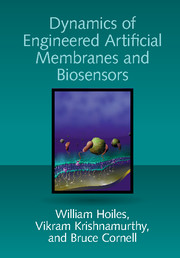Book contents
- Frontmatter
- Contents
- Preface
- List of Abbreviations
- Part I Introduction and Background
- Part II Building Engineered Membranes, Devices, and Experimental Results
- Part III Dynamic Models for Artificial Membranes: From Atoms to Device
- 8 Reaction-Rate-Constrained Models for Engineered Membranes
- 9 Reaction-Rate-Constrained Models for the ICS Biosensor
- 10 Diffusion-Constrained Continuum Models of Engineered Membranes
- 11 Electroporation Models in Engineered Artificial Membranes
- 12 Electroporation Measurements in Engineered Membranes
- 13 Electrophysiological Response of Ion Channels and Cells
- 14 Coarse-Grained Molecular Dynamics
- 15 All-Atom Molecular Dynamics Simulation Models
- 16 Closing Summary for Part III: From Atoms to Device
- Appendices
- Bibliography
- Index
14 - Coarse-Grained Molecular Dynamics
from Part III - Dynamic Models for Artificial Membranes: From Atoms to Device
Published online by Cambridge University Press: 25 May 2018
- Frontmatter
- Contents
- Preface
- List of Abbreviations
- Part I Introduction and Background
- Part II Building Engineered Membranes, Devices, and Experimental Results
- Part III Dynamic Models for Artificial Membranes: From Atoms to Device
- 8 Reaction-Rate-Constrained Models for Engineered Membranes
- 9 Reaction-Rate-Constrained Models for the ICS Biosensor
- 10 Diffusion-Constrained Continuum Models of Engineered Membranes
- 11 Electroporation Models in Engineered Artificial Membranes
- 12 Electroporation Measurements in Engineered Membranes
- 13 Electrophysiological Response of Ion Channels and Cells
- 14 Coarse-Grained Molecular Dynamics
- 15 All-Atom Molecular Dynamics Simulation Models
- 16 Closing Summary for Part III: From Atoms to Device
- Appendices
- Bibliography
- Index
Summary
Introduction
We now move on to a lower level of model abstraction compared to the continuum models of the previous chapters. This chapter describes how coarse-grained molecular dynamics (CGMD) can be used to study important properties of engineered artificial membranes (see Figure 14.1 for perspective on the levels of modeling abstraction). CGMD provides a dynamic simulation model of the engineered tethered membrane that is close to atomic resolution. As explained below, CGMD simulations can be used to estimate important parameters such as the diffusion coefficient of lipids and thereby facilitate building and designing membrane devices such as biosensors (discussed in Part II).
Why use CGMD simulations when one can use continuum models (at a lower spatial resolution) or all-atom molecular dynamics (MD) simulations (at a higher spatial resolution)? In simple terms, CGMD strikes a compromise between full-atom MD (which is often computationally intractable) and continuum theory (which can be inaccurate at a molecular spatial scale). All-atom MD (described in Chapter 15) deals with the trajectory of individual atoms, whereas in continuum theory the probability distribution of the atoms is propagated over time. Since an atom's trajectory is dependent on the trajectory of all other atoms due to intermolecular forces, the computational cost of evaluating all the atom trajectories in an MD simulation is restricted to systems on the nanometer length scale and nanosecond time scale. The main idea of CGMD is to construct “pseudoatoms” (also known as beads) that represent groups of atoms. CGMD then involves evaluating the trajectory of these interacting pseudoatoms instead of specific atom trajectories. An example is the atomistic representation of the DphPC lipid in an MD simulation compared with the coarse-grained representation of the DphPC lipid. In the MD simulation, the DphPC lipid is represented by 154 atoms, while a coarse-grained representation of the lipid ranges from 1 to 11 beads (or pseudoatoms) depending on the coarse-grained force field used. There are 23,716 atom-to-atom interactions between two DphPC lipids in theMDsimulation, while in the CGMD simulation there are between 1 and 169 bead interactions – this significantly reduces the computational cost of CGMD simulations compared with MD simulations. Note that since CGMD only models the trajectory of the beads and not specific atoms, the CGMD model should not be used when atom trajectories are required such as in the estimation of the charge density across an engineered membrane.
Information
- Type
- Chapter
- Information
- Dynamics of Engineered Artificial Membranes and Biosensors , pp. 295 - 352Publisher: Cambridge University PressPrint publication year: 2018
